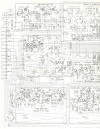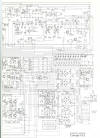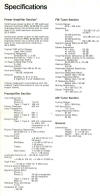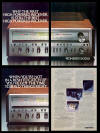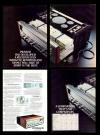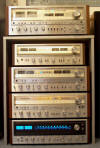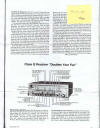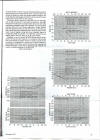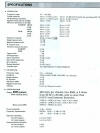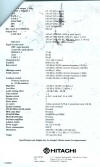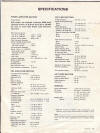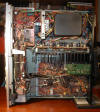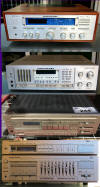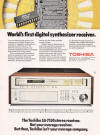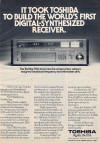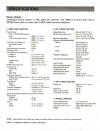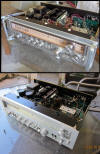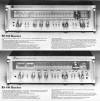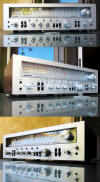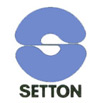|
|
|
 |
||||||||
|
||||||||
|
|
 |
||||||||
|
||||||||
|
The 1976 Pioneer SX-1250 literally set the audio world on its ears in when it was introduced with an aggressive ad campaign. All of a sudden, a Japanese manufacturer, Pioneer Electronics, was now the Top Dog in the mainstream audio world with it's masive and sensational 160 w/ch RMS receiver. I was a Junior at UC Irvine when I first heard about the SX-1250. And, after seeing the first ad for it, I wanted one BAD! Thirty years later, that dream came true. I also got the successor model, the SX-1280, around the same time, but as you can see from the photos above, the SX-1250 is the better built of the two. Simply put, the SX-1250 was the high-water mark for stereo receiver engineering. In fact, 1976 was the highwater mark for receiver engineering (see 1976 Directory of Receivers), period. Never before had so many receiver options been offered by so many manufacturers. Although the SX-1250 caught most of the competition asleep at the wheel, it was quickly followed by the Kenwood KR-9600 (160 w/ch RMS), Technics SA-5760 (165 w/ch RMS) and then the truly monstrous 72 lb. Rotel RX-1603 (180 w/ch RMS), which had obvioulsy been in development before the SX-1250 was introduced. Over the next two (2) years, the rest of the manufacturers came out with their own "monster receivers", but, although some were even more powerful than the SX-1250, none were made with a higher level of engineering and build quality. The SX-1250 was, and still is, considered one of the best built receivers of all time. Pioneer's SX-1010, their top model before the SX-1250, had signaled the start of the legendary "Power Wars" in 1975. The 1010 was also noteworthy in that it marked the ascendency of the Japanese audio industry which had not been taken very seriously before it appeared. The 1010 was quickly topped, however, by the Marantz 2325, then the Sansui 9090 and then the Kenwood KR-9400. So, Pioneer, not to be outdone by its erstwhile rivals, struck back quite convincingly with the SX-1250. It was a bold move. The 1250's clean "all Silver" styling quickly took hold and was shamelessly copied by most of the other manufacturers. The "Blue Light" era of the SX-1010, Marantz 2325 and Sansui 9090DB was officially over! But, the SX-1250 was about much, much more than mere cosmetic ruffles. Its massive Toroidal Transformer power supply is still regarded as one of the best ever, with four hulking 22,000 uf filter capacitors. I believe the SX-1250 was the first receiver with a Toroidal transformer power supply, although Tandberg also featureed them and I am not sure who was actually first. Even though the subsequent SX-1280 was rated at 185 w/ch RMS, 20 wpc more than the SX-1250, the 4 filter caps in the SX-1280 were only 15,000 uf. And the 270 watt per channel SX-1980 had essentially the same power supply as the SX-1250, making the 1250 considerably over-engineered relative to its rated power and leaving the SX-1980 was left with spare dynamic range beyond its rated power, per the lab tests reported by High Fidelity in November 1978. There has always been a swirling controversy over which was the "best" between the Pioneer SX-1250, SX-1280 and SX-1980. Everyone, has their opinion and is entitled to it. I have owned 2 of the 3. From my vantage point, there is no question that in terms of overall build quality, the SX-1250 easily tops the SX-1280 and has the more robust amplifier section of the two, the most important part of a receiver. As for the SX-1980, it is generally considered to be not as well built has the SX-1250, and has essentially the same power supply, but with unobtainium "Power Packs" instead, pushed almost to its limit. In their Test Report High Fidelity stated: "The SX-1980 meets its power rating with a smidgen to spare when both channels are driven. At rated power, this distortion barely reaches half of the tight 0.03% spec. But, while the power is abundant, little remains in reserve; dynamic headroom is just 1/4 dB. Like many separate superamps, moreover, the power amp section requires that the AC input really stay at 120 volts (which domestic supplies seldom do) for the full rated ouptput. But in such amps the high power rating is itself a form of headroom-a hedge against the demands of musical peaks and reduced voltages in the power distribution system." And, since the SX-1980 had Power Packs, unlike the discreet output transistors in the SX-1250, in the event of failure, these proprietary packs cannot be replaced except from a donor SX-1980 (which whould now be prohbitively expensive). It should be remembered that these truly massive receivers were introduced at the very zenith of the Power Wars and around the time that the FTC promulgated new regulations (interesting reading!) regarding the advertising of power output specifications in an effort to bring some "law and order" to the marketplace since manufacturers were falling all over each other to have the bragging rights of "most powerful ever". In essence, these new regulations required that as far as power ratings were concerned, an amplifier had be run a 1/3 its rated power for 1 hour, before the full power test was performed. So, a receiver rated at 300 w/ch RMS would have to be run at constant 100 w/ch RMS for 1 hour before it could be tested for its full power. Unfortunately for many receivers, this rigorous fried their output transistors in the process. Unfortunately, I have never found any test reports of the SX-1250 in Audio, High Fidelity or Stereo Review. There are plenty of four-page ads, like those above, but no reviews. I can only wonder why. The SX-1250 comes with heavy shielding over every section. This attention to detail had simply not been seen in receivers before. And, the perfomance of the SX-1250 was competitive with some of the finest separates of the time. All in all, the 1250 was a "tour de force" (official Pioneer SX-1250 brochure). That's why so many owners swear by it after having owned it almost 30 years! And, I agree. My SX-1250 gets played just about every day and has never had to be repaired. It is 100% original and it feels bulletproof. But, just in case is it needs restoration, here is a video of what is involved in restoring one. Although trendsettting, the styling for the 1250 was tastefully conservative and, for that reason it has held up quite well over time. In the rightmost photo, an SX-1250 sits atop an SX-1010 and beneath and SX-1280, 880 and 1980 to give you an idea of their relatative sixes. The second photo from the right shows an SX-1250 beneath a D-7000, Pioneer's first digital tuner equipped Receiver. The unique styling of the D-7000 came and went very quickly and no other manufacturers followed. Soundwise, the SX-1250 is very enjoyable listen to, with the sense that now matter how good the music sounds, there is always more, much, more, if you just want to turn up the volume at little bit more. The damping factor is nowhere near the 450 of the Concept 16.5 and the bass, like most Pioneers of this era, can sound to some ears (not mine!) a bit muddy and "brooding" compared directly with the punch and tightness of a Concept 16.5. However, the tuner section, even without Quartz Lock, pulls in weaker stations with exceptional clarity, whereas other receivers, including the 16.5, simply can't go there. Although the SX-1250 is still relatively common on E-Bay, for an admission price of around $3,000 now for a fully operational/serviced one, mine will stay just where it is. PROS 'N CONS: A true "game changing" product, exceptional build quality, commands respect by all enthusiasts, all discrete components, easy to repair, rugged and reliable over the decades, trendsetting styling, easy to repair with discrete components, uncompromised sound quality, "high-water mark" for analog receivers, overall the may be the "best" overall stereo receiver ever None, absolutely none |
 |
||||||||
|
||||||||
|
The 1978 Hitachi SR-2004 Class G Receiver, retailed for $950.00 and has the distinction of being the fifth most powerful "all in one" Monster Receiver made during the "Power Wars" of the late 1970's with 200 w/ch RMS on tap, and one of the least well known. In fact, with its dynamic headroom specification of +3db, it just might have been the most powerful of all. And, it WAS the most powerful Class "G" Receiver ever made. Hitachi, which manufactured OEM electronics for most of the major audio manufacturers, was a relative late-comer to the Receiver "Power Wars". However, when Hitachi joined the fray with the SR-2004, they certainly put their best foot forward. Almost all the major internal components in the SR-2004, including the output transistors, were made by Hitachi, making this receiver a real rarity and somewhat of a "purebred". And, outside the box, it has a real about it. Here's a fairly nice video featuring one. And, here's a "deep dive". The SR-2004 had most of the bells and whistles of the other Monster Receivers it was designed to compete against and a few unexpected extras like switchable IF Bandwidth (wide/narrow), "AutoLock" FM Tuning (triggered by changes in the capacitance when you touch the tuning knob) to prevent FM drift, and a SAW Filter. In fact the 5-gang front end on the SR-2004 was part of one of the best analog receiver tuners ever. Be sure to take a look at the specifications pages above. The SR-2004's deluxe features also included two (2) different Audio Muting levels, a front panel Mic Input w/ level control and a very comprehensive Tone Control section with bass, mid-range and treble controls with switchable frequency settings for the bass and treble controls. Although it weighed in at 56.2 pounds, somewhat less than the Pioneer SX-1250's 65 lbs., what really made the SR-2004 stand out was its "Class G" Amplifier. In fact, according to a review from the December 1978 issue of High Fidelity (in middle photos above), it was capable of dynamic peaks of 400 watts/ch "that gives it a shot a first place in the receiver power race" and found that the power output was actually more like 240 w/ch RMS. Leonard Feldman in Audio's November 1978 issue confirmed dynamic headroom of just under 4.0 db, "higher than that of any other receiver we have measured since was began testing for this new specification". And, better yet, the Hitachi stayed relatively cool, a good indicator for long transistor life. That's why the SR-2004 was popular mostly among sound reinforcement professionals and DJs. Roger Russell, former loudspeaker Guru for McIntosh Labs, was kind enough to provide me with a copy of the review from his collection of audio magazines, including his signature on the sitcky note! The power supply was dominated by a huge toroidal power transformer surrounded by four (4) huge capacitors, 2 per channel. All of the internal electronics were shielded by metal enclosures so that barely any wiring is visible. And, of course, all eight (8) discrete output transistors on the massive heatsinks were proudly marked "Hitachi". Functionally, the Hitachi gives up very little to the Pioneer SX-1250 performancewise. However, whereas most monster-era receivers sound "loud enough" with the volume set to 9:00, the Hitachi needs to go to 12:00 for adequate volume. Conversely, whereas most receivers are maxed out at 2:00, the Hitachi just keeps going to 5:00. So, now you know a few of the reasons why the Hitachi SR-2004 is one of the greatest stereo receivers ever made and one of my personal favorites. Unfortunately, Hitachi was never able to establish an audio brand identity in the American market, so the Hitachi audio line essentially disappeared after 1984 and the SR-2004 is now just a vague memory in the minds of most enthusiasts. For the technically inclined, what follows is a description of "Class G" amplification from a forum at audiokarma.org: Class G, Class H Amplifiers Explained:
Soundcraftsmen made some EXCELLENT sounding Class H amps. The
Hitachi Class G amplifier allowed them to make a 200 wpc unit
that could double that output as required for short periods.
These are popular where high-power and cool-running are needed,
such as in pro applications and in mobile (cars) systems due to
their efficiency. I have four of the big Soundcraftsmen amps,
and let me say again, they are GREAT sounding amps (or they have
no sound of their own, I guess is the point of my comment). Here's a different point of view from an audio technician, "Ron", who e-mailed me in response to this page: "My other comment has to do with your definition of Class G, where you state: "an ordinary class AB amplifier is driven by a multi-rail power supply". This is incorrect. Classes A to D are defined by conduction angle of the output devices, regardless of number or level of supply rails. (In Class A, output devices conduct at all times, through 360 degrees). In Class AB, between 180 to 360 degrees, depending on input signal level. In Class B, 180 degrees. In Class C (never used for audio), less than 180 degrees. In Class D, alternating conduction through a small angle.) In contrast, Classes G and up (coined in Advertising, rather than Engineering) define the power supply and not the output device operation. IOW, a Class G supply can still feed a Class A, AB, B (or even C or D) output stage." PROS 'N CONS: 600 WPC power meters (who else had those?), runs very cool, rugged look Bland, anonymous styling, vinyl covering on case, need to turn up the volume at bit to tap into the power reserves |
||||||||
 |
||||||||
|
||||||||
|
The 1979 Kenwood KR-9050 receiver, retailed for $1,250.00 and has the distinction of being the most powerful Kenwood receiver of all, featuring a "High Speed" DC amplifier rated at a romping 200 w/ch RMS. To keep the massive power amplfier section cool, most of the inside is comprised of a massive heatsink, as you can see in the middle photo. It directly followed legendary KR-9600 but somehow never achieved the same level of popularity or status, although it had a higher power rating by 40 w/ch RMS. In addition to the prodigious power output, the KR-9050 also incorporated Kenwood's most advanced analog tuner technology. You can learn the more intricate details about the KR-9050's "High Speed" DC amplifier design, and see the rest of Kenwood's receiver ilneup for 1978, in this Kenwood Full Line Brochure. Soundwise, I consider the KR-9050 to be in the top rank of vintage Receivers. The tuner, with its Quartz Lock, adjustable IF bandwidth and two-level Stereo Sensitivity, features leaves little to be desired. A large number of stations come in "loud 'n clear". Better yet, the "Hi-Speed" "Dual Power Supply" amplifier is just that: lively and powerful. And, it looks very impressive with a real walnut case with subdued panel lights. However, on the downside, the switchgear is mostly plastic, with thin metal caps, which can break off easily and I have seen some with that "toothless" look. The selector knobs, with plastic cores, also lack the affirmative click of the Pioneer SX-1250 which had solid metal machined knobs with set screws. Fortunately, the KR-9050's exceptional overall performance saved it from being a gift! PROS 'N CONS: Strong performer in all respects, one of the very best of its time, exceptional analog tuner with Quartz lock Heatsinks are fully enclosed, knobs are plastic core with metal caps, feels a little cheaper than it should |
 |
||||||||
|
||||||||
|
The 1976 Rotel RX-1603 Receiver, retailed for $1,100.00 and had the distinction of being the "most powerful receiver in the world" when it was first introduced in 1976 (180 w/ch RMS) shortly after the Pioneer SX-1250 (see 1976 Receiver Directory). And, it was certainly the most powerful Receiver ever made by Rotel, the British audio manufacturer. But, this powerful of a receiver coming from a relatively minor manufacturer should not come as a surprise since in 1978 Rotel introduced the stunning 117 lb. Rotel RB-5000 Power Amplifier (also shown at right, above) rated at an astounding 500 w/ch RMS and priced at a very affordable $2,650! According to Stereo Review's test report, it even exceeded this outrageous output and could not be switched from a preamplifier since it sucked 3,200 watts from a 120-volt power line at full tilt. I suspect that the RB-5000 has more in comming with the RX-1603 than just the knobs! Maybe the power transformers are even the same. The RX-1603 was of completely conventional design electronically, although the cabinet was designed to separate the front from the rear (tuner/pre-amp & amp.) because it was extraordinarily deep as a single unit. This was similar in concept to the subsequent Sansui G22000/G33000, which were a more refined execution of this basic approach. The inside of the amp. section is dominated by a huge "Rotel" toroidal transformer with two 22,000 uF 80V power capacitors literally the size of coffee cans. The output transistors were top of the line hand picked and hand tested Sanken 2SC1586s. And, those front handles were not just for show, either. Given its bulk, weighing in at over 72 lbs. with both components attached, it was very difficult to move around without the handles. This page details an RX-1603 rebuild, and provides a good look at how it is constructed. I've listened to my own RX-1603 on a fairly regular basis and the sound is full and rich in detail. My speakers are not particularly sophisticated (yet) so the more esoteric elements of its performance I am not worthy to evaluate. It seems to be SIGNIFICANTLY more powerful that the Pioneer SX-1280, even though the rated power output is about the same. I read somewhere on the net that the RX-1603 actually specs out a around 250 w/ch RMS, but I have not yet confirmed this personnally with a benchtest at my Tech's for fear of ruining my back hauling it over there! The RX-1603 also gained a degree of immortality after being featured on the cover of Stereo Review's issue covering the stunning rise of Monster Receivers in 1978. It's the second unit from the bottom in the rightmost photo. Personally, after the Marantz 2600, I think it's the most intriguing looking Monster Receiver. The FM performance seems a little weak compared to the competition, however, the amplifier section more than makes up for it by delivering a powerful, punchy bottom end that doesn't overwhelm the crisp highs and detailed mids. It's a keeper. PROS 'N CONS: Massive presence just sitting still, beefy bass performance, solid feeling to all controls Massive pain to move even with handles, looks like the budget ran dry in back |
 |
||||||||
|
||||||||
|
The 1980 Marantz SR9000G retailed for $950.00 and replaced the Model 2600 (top photo, middle panel) as the top Marantz receiver worldwide. It was also the last Marantz receiver manufactured by Marantz Japan. It was sold only in Europe and was never imported to the USA, however, it served as the design basis for the Marantz SR-8000 (based on the European SR-8010), sold only in North America, which was only half as powerful for reasons unknown. By this time, the receiver "Power Wars" of the mid-70's was winding down but why Marantz did not bring the SR9000G in America remains baffling. What attracts me to the SR9000G is its unique blend of old and new school. It can be viewed as an udated 2325. It paid homage to the very first Marantz receiver, the 1967 Model 18, in the layout of its knobs and having rectangular buttons, unlike the round buttons of previous generations. It also used the same iconic fonts. The middle panel, above, shows an SR9000G atop a Model 18 for the sake of comparison. However, the SG9000G had several features that no Marantz receiver before it, including the 2600, ever had: a quartz synthesized digital turner, auto scan tuning, a 7 pre-set "Computuner", LED power meters and an FM multipath indicator. Some vintage audio collectors have considerable disdain for Marantz equipment from the 1980's citing a perceived lower quality of construction and overall performance than before. Most of Marantz's TOTL stereo receivers of the 80's are in the composite photo far right starting with the SR9000G, then the SR8100DC, SR940 and TA170AV. The 1989 SR3600 Dolby Surround Receiver is not included. The 1984 SR940 (100 x 2) was particularly controversial as it was all digital and emlimnated knobs entirely. And, sadly, it was also the first Marantz receiver with an entirely plastic face, which is where the perceived decline in quality became quite obvous. However, many critics of 80's Marantz receivers have never owned one, or even heard one. Although not as big and powerful as the truly awesome Marantz 2600 the SR9000G was still a "Monster Receiver" in its own right featuring a (first for Marantz) DC amplifier at a rated 130 w/ch RMS. It also eliminated the 2600's cooling fan, which many claim was audible at low levels. I have listened to a 2600 and never noticed the fan, but who listens to a 2600 at low levels anyway? A 2220B sounds better at low levels anyway. Regarless, the SR9000G did mark a turning point in Marantz's fortunes, as the Company began a steep downhill slide in prestige after it was taken over by Dutch electronics giant Philips in 1979. Recently, I made the acquaintance of one Richard Jordan, Product Manager and VP of Product Development/Marketing for Marantz USA, who oversaw the development for all Marantz audio components (including receivers, video products and loudspeakers) from 1974 to 1987. Regarding the 9000G, he had this to say: "120v version available, was sold through the military PX & audio clubs... I recall the 9000 was the last Marantz receiver built by Marantz Japan..." "Around that time, Phillips (Netherlands) had bought the off-shore assets of Marantz, but Marantz USA kept the North American territory. John Ballantine did all the Marantz receivers till '87. Yes, I would write a book about the 2500/2600, it was a wattage horsepower race with Pioneer & Technics. Over lunch 1 day I was with the pro-audio engineers we decided to design a receiver to kick butt... We took our amplifier circuit from the 510m pro amplifier, tuner/scope from the best Marantz component line, designed a great photo preamp circuit here in the USA. Next I went to Japan with 1 of the pro engineers and we presented our plan for the 2500... It took the Japanese team about 2 weeks to confirm back their understanding. Then it took another 12 months going through tooling and evaluating prototypes in order to start mass production. At the start of production I was in Japan and hand carried back the 1st production samples. To say the least it was a big hit for sales and today a sano 2500/2600 can sell for $5-9K. In 1 of my (3) systems I still use a 2600... I have been offered big $$ for it but intend to give it to my son..". "Some debate what stereo receiver was king of the hill?? But the 2600 had the most power plus scope, quartz lock tuner, incredible phono preamp. Unfortunately, the competition's jumbo receivers all failed the rigorous FTC preconditioning test. But since the 2500/2600 used the patented, servo-controlled tunnel heat sink from the pro amplifier 510M it did just fine when pushed hard.... Regarding the purchase price to employees, we typically could get significant discounts. But, whenever I wanted a product, I would get it directly from Marantz Japan and handcarry back from Japan since I was over there 4 or 5 times a year..." So, the controvery over whether the 9000G is a "legitimate Marantz" product, as opposed to merely a Phillips step-child, is over. Richard Jordan, the "father" of the Model 2600 has confirmed that indeed the SR9000G was developed at Marantz USA by the same minds (particulary his and John Ballantine's) that created the legendary 2500 and 2600 monsters (although they both had some reliability issues and did not make it here) and made in the same factory. Despite this pedigree, however, the 9000G has never acquired cult status, although those who have actually heard one give it rather high marks for its performance. Unfortunately, the SR9000G had obvious signs of cost cutting. The buttons were plastic, not metal capped. Gone were the Toroidal power transformer, the "cooling tunnel" and "dual secondary" power supplies of the previous top of trhe line models. Also gone were double-ganged (independent left/right) tone controls and, sadly, even the brand-identifying "Gyro-Touch" tuning. Marantz had digitial tuners with Gyro-Touch but, mysteriously, it did not appear on another Marantz recever until 20 years later on the massive SR-14EX. Lastly, the SR9000G's wood sleeve enclosure was covered with a tacky vinyl rather than real walnut veneer. And, It was not sold with a metal case. No wonder there was a perception of lower quality! Once I got my SR9000G, being unable to find any information about it at the time, I took it over to my friend Tom Ishimoto's shop (Tom used to work with Richard Jordan at Marantz in the 1980's) and he benchtested my then 35 year old receiver at 150 w/ch, 20-20kHz at 0.022% THD, a performance that puts it in the Monster Receiver league, albeit barely. By the way, Tom is not your average Tech as he developed the servo-lock and quartz-lock FM circuits while he was at Oknyo. But, even he did know about the SR9000G! That's how rare a bird it was. Of interest, on an E-Bay auction for an SR9000G, the Seller posted the following information from "Nico" in Germany: "The real first digital Marantz receiver was the SR 8010 DC (100x2). It came out in 1980 and looked like the twin to the SR9000G...What these receivers all have in common is that they were developed, designed and produced in Japan....and Philips had not yet taken over Marantz. In the pre-amplifier section MOS FET transistors and in the main amplifier section selected Japanese EBD transistor are absolutely the same like the output signal and not similar....In my opinion the SR 9000G is the best receiver Marantz ever built and not the model 2385 which many people consider to be the best. I compared these two receivers side by side and I think the SR9000G performs better because of the fantastic authentic sound and the harmonic distortion of less than 0.01%, thanks to the DC amplification, which the models before 1980 (like the 2385) did not have. The power of the SR9000G is nearly the same power of the 2385 and, therefore, enough for a hifi freak like me. I do not appreciate the two bigger receivers (2500 and 2600) because of the built-in-fan which is not comfortable in daily use at low volume level." Incidentally, my Tech recently told me of the owner of a 2600 who disconnected the fan of his 2600 and "fried the amplifier". Geeez, folks! The fan was there for a reason! PROS 'N CONS: Unique early "80's" styling by the legendary John Ballantine, very satisfying performance, ample power output Build-quality is not what it should be for a TOTL Marantz, controls feel frail, fragile vinyl case |
||||||||
| T |
 |
||||||||
|
||||||||
|
The 1978 Toshiba SA-7150, retailed for $1,195.00 and has the distinction of being the "world's first" receiver with a Quartz Digital Synthesizer Tuner. In that way it was the forefather of all that was to come. It was also an FM lover's delight, since it also had built-in Dolby FM (no module needed), switchable IF Bandwidth (wide/narrow), Hi-Blend and even Air Check (a white noise generator) for setting recording levels. Some may remember that there were a couple of other receivers that had come out before with a digital display for the tuner, the mid-priced 1972 Magnavox 1500 Plus DTI (50 w/ch RMS) and the rather expensive 1975 Hervic HR150 (75 w/ch RMS). However, what they both had an analog turner with a digtal display, so neither was a true "digital turner" by any means. And, unfortunately, the performance of the Hervic's turner was not very impressive. So, the SA-7150 was the certainly "world's first" digital synthesized tuner as Toshiba's ad, above, so proudly proclaims. Plus, all this tuner wizardry came backed with a powerful 150 w/ch RMS amplifier featuring a "dual mono design" supported by a huge toroidal power transformer. In fact, the Toshiba engineers were so fanatical about the power supply that the SA-7150 even had a separate power transformer for the tuner/pre-amp circuits. In every respect, that was the "state of the art" in 1978. And, that's why it's a favorite. To quote from the Owner's Manual: "The all-important power supply for the SA-7150 is divided into separate supplies for the pre- and power amplifier stages. the power amplifier supply is then further divided into independent left and right power supplies, employing separate pairs of high grade heavy duty electrolytic capacitors (15,000 uf x 2 per channel) and a massive Toroidal transformer for excellent regulation. The SA-7150 is thus able to deliver its huge reserves of power right down into the ultra-low frequency region with greatly reduced dynamic crosstalk distortion. Big advances in audio circuit technology have given the SA-7150 Digital Synthesizer AM/FM Stereo Receiver an incredibly huge reserve of output power at practically non-existent distortion levels. Super-low-noise dual transistors (developed especially for Toshiba audio equipment) in the 1st-stage differential amplifier, and parallel push-pull connected power transistors (of particularly outstanding transient response) in the power stage, deliver 150 watts of power per channel (both channels driven) into 8 ohms from 20 to 20 kHz with no more than 0.05% THD." Toshiba, which also manufactured OEM electronics for most of the major audio companies during the 1970's, was a late-comer to the Receiver "Power Wars". However, when they joined the fray with the SA-7150, they certainly put their best foot forward. Almost all the internal components in the SA-7150 were made by Toshiba, making this receiver, like the Hitachi SR-2004, a real rarity. And, it has a very distinctive look which has aged rather well, with the bright digital display and multi-color LEDs contrasting nicely with the legacy analog Power Meters. rated up to 500 watts. The advanced tuner section in the SA-7150 heradled Toshiba's worldwide leadership in tuner technology. Toshiba placed itself in the forefront in 1974 Toshiba with the release of their ST-910 Digital Tuner (also marketed under the "Aurex" brand) which was the most advanced tuner in the world. And, much of this technology was incorporated into the SA-7150. PROS 'N CONS: Unique hybrid digital/analog styling, audiophile-oriented circuit design, impressive FM Tuner Front door is too heavily sprung, vinyl case looks out of place for this league, internally mounted heatsinks |
 |
||||||||||||||||||||
|
||||||||||||||||||||
|
The 1977 Setton RS-660 certainly qualifies as one of the rarest of the Monster Receivers. And, one of the nicest looking to boot! The Setton line had only three (3) receivers, the RS-220, RS-440 and the top of the line Setton RS-660. The RS-660 retailed for $900.00, making it one of 1977's more expensive receivers. The Setton line was allegedly designed by Allain Caire, an acolyte of Pierre Cardin (although it is mistakenly claimed that the master himself was involved) and was marketed to an "elite" audience. Jack Setton was actually the French distributor for Pioneer and had decided to come to market with his own brand. In Europe, Setton distributed some really interesting equipment, like the outrageous (for the time) RCX-1000 modular tuner/pre-amp, which shares only its knob design with the RS-660 shown here. Viewed from the front the RS-660 is rather large. The middle photo shows the smaller Setton RS-440 atop a Concept 16.5, just to give you an idea. All the Settons featured a unique "Security Panel" display, with indicators for "Heat", "Clipping" and "Protection". This included the fairly outrageous BS-5500 Power Amplifier (middle photos), a true "dual mono" design, complete with 2 power switches! The BS-5500 was basically the RS-660's power supply section multiplied by 2. The power supply filter caps in the RS-660 were fairly substantial at 15,000uF x 2. It also had switchable turnover frequencies for the Bass and Treble control and a Hi/Lo phono impedance setting on the rear panel. Performance aside, a considerable amount of money was invested in the RS-660's "cosmetics". All the buttons are solid metal and the feel of the controls, with their nylon inserts, is almost silky. It is a real pleasure to use. But the vinyl on the case is another story entirely. It shrinks with age and get a greasy feeling How could they do this? I couldn't stand it, so I had had the vinyl case on mine redone with matching grain real walnut veneer by "Merrylander" at AudioKarma.org and I'm pretty sure it's now one of the nicest looking RS-660s in existence. On a side note: The Setton receivers have always been a source of some controversy since it is well known that they were not manufactured by Setton, but outsourced to a Japanese OEM. However, that issue has now been resolved for the most part, since it appears that the Settons were manufactured in Japan by the same outfit ("Planet Research") that did some Lafayette Radio products, like the LR-9090. However, other people claim it was made by Trio Electronics, parent of Kenwood, or even Pioneer. I actiually acquired an LR-9090 just to compare them and can attest that internally, they are about 90% the same, although the power transformer and the pre-amp board are different. So, they are not identical behind the faceplate but clearly made by the same manufacturer. And, while not identical twins, they are clearly brothers. (See middle comparison photo.) Photos of the internals of the LR-9090 and RS-660 are in the middle photos above. Photos of my LR-9090 are on the right. Sadly, I can't really say I listen to my RS-660 very often because the Setton Receivers have a dreaded Achilles Heel: the power switch is incorporated into the speaker selector and sometimes this can create an electrical arc which destroys the now unobtainium selector. Fortunately, the much more common LR-9090 has the identical switch. There are also workarounds, including adding a relay to take the stress off the power switch. I bought my LR-9090 as a source of parts for the Setton. This thread contains a rather lengthy discussion of the RS660's virtues and vices. When professional critics evaluated the performance of the Setton Receivers, they received fairly glowing reviews. Unfortunately, I haven't found any English reviews of the RS-660. But, below is what I found:
PROS 'N CONS: Overall sound quality, positive feel of the controls, high-end "Pierre Cardin" styling, innovative Security Panel Tacky vinyl walnut clad case, "a Lafayette with lipstick"
|
||||||||||||||||||||
|
|
|
||||||||
|
|
||||||||
|
|
||||||||






